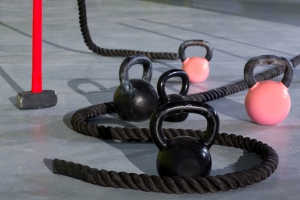Block Training: Change Your Schedule & Get More Out Of HIIT Workouts

Dayton Kelly
So you’ve hopped on the High Intensity Training (HIIT) bandwagon and are ready to ride it to big gains and athletic success. But are you doing it properly? While few employing the strategy of HIIT realize this fact, research has been consistently reporting that the way we traditionally incorporate HIIT into our training programs may be stealing away some of the fitness adaptations we work so hard for. All it takes to reap more out of your workouts is a little rearrangement of your workout schedule.
While some may solely perform HIIT in their workout program, most utilize a combination of long distance cardio (LDC) and HIIT. This mixture stems from the fact that HIIT requires a lot of energy (which is partially why it is so good) and, in high doses, can lead to overtraining (Issurin, 2008). This has led experts and common users alike to adopt a mixed program of HIIT and LDC.
Commonly, programs designed from this mixed approach are composed of weeks of training that may contain two or three days of HIIT and three or four days of LDC. This approach, however, may be diminishing your results for three reasons:
- Different forms of training compete for adaption. Research has shown that the increases in power that characterize HIIT may be reduced by LDC(Issurin, 2008). In the same way, aerobic power (strength maintained over long periods of time) may be comprised by HIIT (Issurin, 2008). This seems sensible. A different set of adaptions is required for improvements in each and as we only have finite energy stores to use to improve our systems, these resources become divided amongst different types of training.
- Programs employing consistently high levels of HIIT each week lead to high rates of overtraining(Issurin, 2008). Continually performing high intensity training every week does not provide our bodies with the break it needs to recover.
- Dividing your time between different energy systems may mean you do not spend enough time in any of them(Issurin, 2008). Let’s face it, very few of us have enough time to fit fourteen workouts into a week. Thus, each day we are forced with the decision of choosing whether to perform HIT or LDC or something else (fitness requires more than only these two workout types). If we do not spend sufficient time in either discipline, we undercut our potential for improvement in a given week (Issurin, 2008).
 Luckily, Fast Twitch Grandma authors do not just bring you problems, we bring you evidence-based solutions. The solution for our problem at hand seems to lie in the concept of block training. Block training is a method of program design in which one aspect of fitness is focused on for a short period (or block) before returning to a block of another fitness aspect. Instead of performing HIIT three times a week and LDC three times a week, block training would suggest we do three weeks of LDC with one day of HIIT a week before a week of only HIIT.
Luckily, Fast Twitch Grandma authors do not just bring you problems, we bring you evidence-based solutions. The solution for our problem at hand seems to lie in the concept of block training. Block training is a method of program design in which one aspect of fitness is focused on for a short period (or block) before returning to a block of another fitness aspect. Instead of performing HIIT three times a week and LDC three times a week, block training would suggest we do three weeks of LDC with one day of HIIT a week before a week of only HIIT.
The same volume of training in each discipline is done, but at different times. By focusing on only one training aspect at a time while maintaining the others, we circumvent the aforementioned issues. The benefit of this change has been recorded in numerous varieties of athletes. Cyclists demonstrated an approximate 5% VO2 max and 10% lactate threshold power output increase under block training relative to improvements under the traditional mixed design (Breil, Weber, Koller, Hoppeler, & Vogt, 2010).
Similarly, alpine skiers saw a 6% VO2 max and 10% lactate threshold power output improvement with block training while control groups performing mixed design saw no improvement (Rønnestad, Hansen, & Ellefsen, 2014). With the clear benefits in mind, block training is likely a good way switch up your routine. This recommendation comes with an asterisk! Unfortunately, nothing is ever as simple as a one-time switch over.
Takeaway
While block training does seem to be beneficial in the literature, it is likely because so many athletes are currently doing a mixed design. By changing things up, they introduce a new stimulus for adaption and see greater improvements. As well block training seems to be superior over long periods of time while the traditional mixed design may see greater short-term adaptations directly before competition (Issurin, 2008). With this in mind, do a bit of both! Switch to block training and then back to a mixed style after a few rounds. In this way, you can keep you body on its toes all year long getting the fitness adaptations you deserve! Good luck and happy training!!
Are Plant-Based Protein Drinks Effective for Exercise Recovery?
Dayton Kelly This article was adapted from a combination of speeches given at the European Sports Science Conference 2018, most notably Meghan Brown (UNIVERSITY OF GLOUCESTERSHIRE, UNITED KINGDOM). Protein supplementation has been repeatedly demonstrated to...Is Milk the Perfect Recovery Drink?
Dayton Kelly Optimizing recovery allows you to achieve the most adaptation per workout and reduces the required rest necessary before a subsequent workout. As such, millions of research dollars have been invested into discovering and...Cell Phone Activity Trackers
Dayton Kelley As advances in technology continue to rapidly drive the world of exercise forward, we are faced with new and improved ways to monitor and promote our fitness. This capacity to monitor our training...Effects of Dehydration on Athletic Performance
Dayton Kelly This article was adapted from a combination of speeches given at the European Sports Science Conference 2018, most notably Mark Funnell (Loughborough University, UK). Decades of research have been dedicated to determining the...Ice Baths- Help or Hinder?
Dayton Kelly This article was adapted from a combination of speeches given at the European Sports Science Conference 2018, most notably Cas Fuchs (Maastricht University, Netherlands). Immersion in cold water has been long thought to...The Best Workout Combination: Endurance Training and HIIT
Dayton Kelly This article was adapted from a combination of speeches given at the European Sports Science Conference 2018, most notably David Bishop (VICTORIA UNIVERSITY / AUSTRALIA). Long distance, low-intensity endurance training has been preached...References
Breil, F. B., Weber, S. N., Koller, S., Hoppeler, H., & Vogt, M. (2010). Block training periodization in alpine skiing: effects of 11-day HIT on VO2max and performance. European Journal of Applied Physiology, 109(6), 1077-1086. doi:10.1007/s00421-010-1455-1.
Issurin, V. (2008). Block periodization versus traditional training theory: A review. Journal of Sports Medicine and Physical Fitness, 48(1), 65-75. Retrieved from http://search.proquest.com/docview/202718950?pq-origsite=gscholar.
Rønnestad, B. R., Hansen, J., & Ellefsen, S. (2014). Block periodization of high‐intensity aerobic intervals provides superior training effects in trained cyclists. Scandinavian journal of medicine & science in sports, 24(1), 34-42. doi:10.1111/j.1600-0838.2012.01485.x.
















